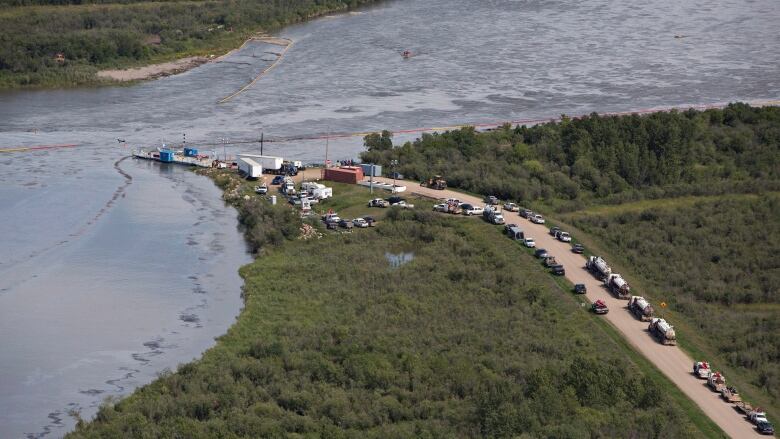Report says recent water tests after Husky oil spill coming back within guidelines
North Saskatchewan River water hasn't exceeded national guidelines for week and a half

A report released by Husky Energy says recent water samples of the North Saskatchewan River are coming back within drinking water guidelines.
So far, more than 900 water samples have been analyzed for contamination. Of those, only five samples, all taken within 20 kilometres of the spill, exceeded national drinking water guidelines.
Two weeks ago, a Husky Energy pipeline spilled more than 200,000 litres of oil and diluent into the river near Maidstone, Sask. Ever since, workers have been trying to contain and remove as much of the spill as possible.
The study saidthe last sample to exceed national guidelines was takenJuly 24, more than a week and a half ago. The report also mentions water around intakes at NorthBattlefordand Prince Albert have come back clean.
Experts say the national water guidelines are very stringent.
"They are very health conservative, as you might imagine," said toxicologist Paul Nony with the Centre for Toxicology and Environmental Health, agroup working on analyzing the spill data. "They represent water that is safe to drink, every day, for a lifetime."
Water sampling is still ongoing, and recommendations about the risk of oil affecting river water intakes will come after a formal assessment is finished.
Preliminary results from a risk assessment will likely come back within the next seven to ten days. However, the province's Water Security Agency says it will only clear water treatment plants in North Battleford andPrinceAlberttoreopen when it is clear there is no further danger ofcontaminated water.
"There's a number of things we need to see as a regulator," said agency spokesperson Patrick Boyle. "How much of the oil isn't accounted for, how much has been captured, where the rest is. We need to look at evaporation, the degradation, what's in the riverbed, the sediments that are coming in."
The Water Security Agency has started an independent sampling program and will be doing more in the coming days.
The study was undertaken by experts from Saskatchewan's Ministry of the Environment, the Saskatchewan Water Security Agency, Health Canada, Husky Energy and other groups. All of the sampling data was taken by third party consultants.
Where is the oil?
The study saidthe spilled oil has mainly been found on the shoreline of the river, in the river water and in river sediment, mainly within 20 kilometres downstream of the spill.
However, it's still not clear how much sediment has settled onto the river bed. While oil covered shorelines can give experts a good idea as to where the sediment would be located, more study of the river bedneeds to be done.
"It gives us a good idea where those heavier oils might be, down below the water surface," said toxicologist Nony. "We have prioritized sediment sampling corresponding to visual oiling, so we can get some idea of what's underwater."
It's also not clear how stable that oil-covered sediment would be. The sands of the North Saskatchewan River shift often, especially during freezing and thawing, when large chunks of ice can scrape along the river floor.
"It is a very dynamic river," said Nony. "There are iceberg-like chunks of ice that could come down this river as it starts to breakup and thaw, and there's the potential that there could be materials released through that."
As a result, the government is planning to do long-term testing of the water, especially around water intakes at North Battleford and Prince Albert, to make sure the water continues to be safe.












_(720p).jpg)


 OFFICIAL HD MUSIC VIDEO.jpg)
.jpg)



























































































